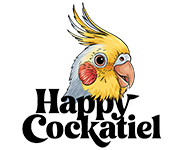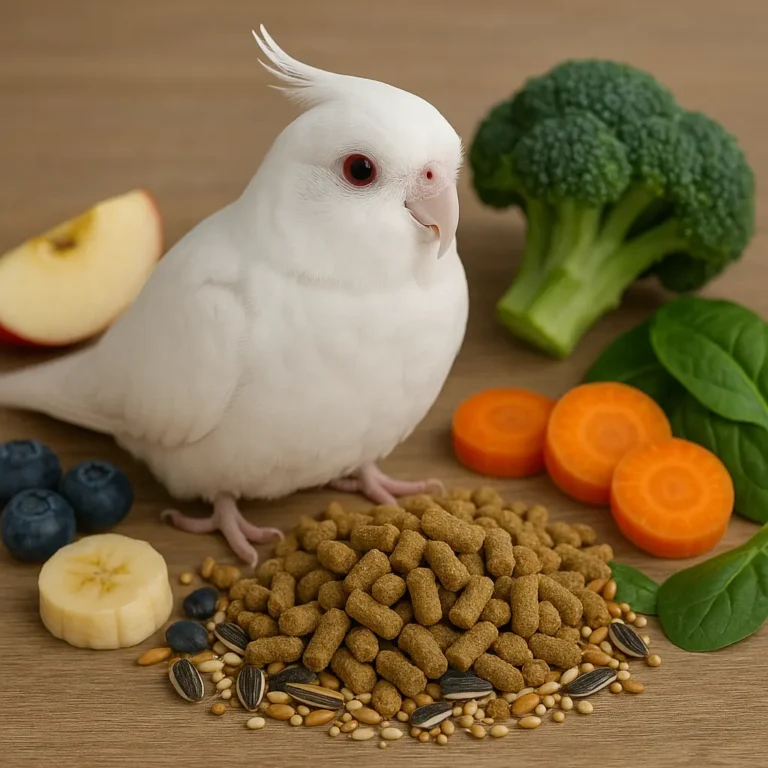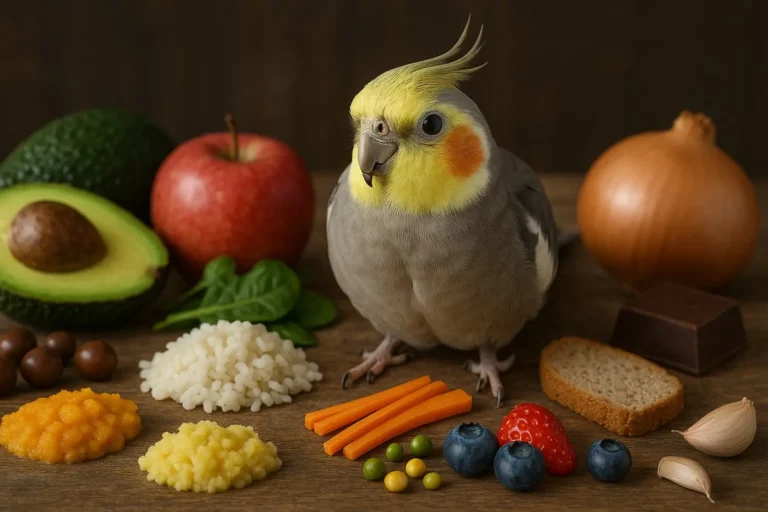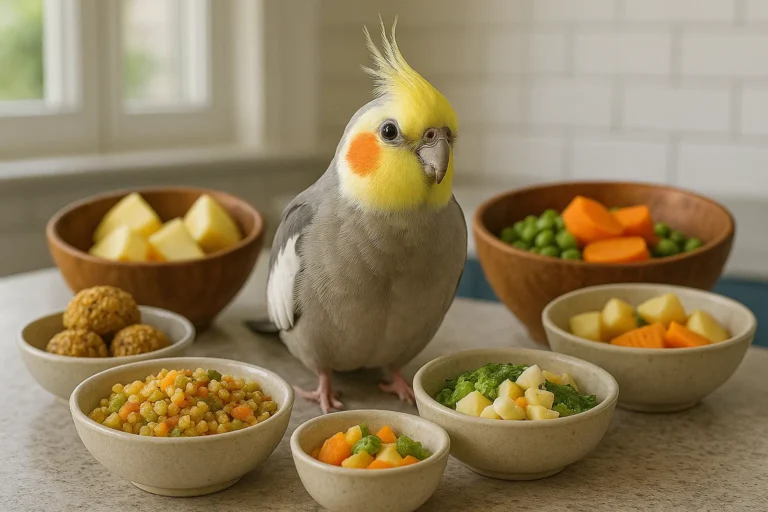Cockatiel Baby Diet: What to Feed Chicks from Hatch to Weaning
Raising baby cockatiels is one of the most heartwarming parts of being a breeder. But feeding them right? That’s where things get serious. The cockatiel baby diet plays a huge role in how healthy and tame your chick will be. From the moment they hatch to the day they eat on their own, every stage of their diet needs care and attention.
In this guide, I will walk you through what to feed your baby cockatiel from day one to weaning. Whether you’re hand-feeding or just watching the parents do their job, this post will help you make sure your chicks are getting the best start in life.
Why the Right Cockatiel Baby Diet Matters
Feeding your baby cockatiel the right food is about helping them grow strong bones, healthy feathers, and a good immune system. A proper cockatiel baby diet gives them the energy to grow healthier. It also plays a big role in taming, especially for hand-fed chicks. I raised many cockatiels over the years, and I noticed that well-fed chicks are healthier and also friendlier.
There is also a big difference between chicks that are hand-fed and those raised by their parents. Hand-fed baby cockatiels tend to become more attached to people, while parent-raised babies can be a bit more independent. But no matter how they are fed, the quality of their diet affects everything from their mood to their future health.
Diet for Newly Hatched Cockatiel Chicks (0–7 Days)
What They Can Eat
In the first week of life, cockatiel chicks are tiny, blind, and completely dependent on you or their parents. If you’re hand-feeding, the only thing they should eat is a high-quality commercial hand-feeding formula. This special formula is designed to give chicks everything they need to grow in their earliest days. Some of the brands I trust and recommend are:
- Kaytee Exact Hand Feeding Formula.
- Higgins Intune.
- Zupreem Embrace Plus.
The formula should be smooth and warm, not too thick. Protein and warmth are key. Cold food can slow down digestion, and that can lead to serious problems. Think of it like feeding a newborn baby, they need warmth and softness.
Feeding Frequency and Technique
During this stage, your baby cockatiel will need to eat every 2 to 3 hours, even at night. Yes, that means setting your alarm! You’ll need a feeding syringe or soft-tipped spoon. The formula should be heated to about 102–108°F (39–42°C). Always test it on your wrist first—just like with human baby bottles.
Clean your feeding tools before and after every meal. Dirty tools can cause infections in chicks, which can be life-threatening at this age.
Diet for Cockatiel Chicks Aged 1–2 Weeks
Consistency of Food
As your baby cockatiel hits the second week, it begins to grow fast. Its eyes start to open, and feathers begin to peek out. You can make the formula a little thicker now, but it should still be easy to swallow and warm.
Feeding Schedule
Now, you can stretch feeding times to every 3 to 4 hours. One nighttime feeding is still necessary. Your chick’s crop (the food pouch on its chest) should be empty or nearly empty before each meal.
Signs of Proper Nutrition
You’ll know your chick is doing well if it’s gaining weight daily. I recommend using a small digital kitchen scale and writing down the weight every morning. Healthy droppings should be soft but not watery. The chick should start stretching, peeping more, and showing curiosity, it’s a sign that its body and brain are developing nicely.
Diet for Cockatiel Chicks Aged 3–4 Weeks
Food Adjustments
At 3 to 4 weeks, your cockatiel baby becomes more active. Now is the time to make the formula thicker. Some breeders (myself included) begin adding a tiny pinch of probiotics or veggie puree to help their gut adjust ask your vet before doing this, though.
Fewer Feedings
You’ll now feed the chick 3 to 4 times a day, and you can stop nighttime feedings. This is a huge milestone for both of you! Your chick can go longer between meals and is starting to act like a little bird instead of a helpless baby.
Beginning Exploration
At this stage, you’ll see chicks pecking at everything, your hand, their bowl, and anything shiny. That’s your cue to introduce soft foods like:
Soaked pellets
Tiny bits of millet spray.
They may not eat it yet, but it helps them learn what food looks and feels like.
Introducing Soft Solids (Weeks 5–6)
Beginner Foods
This is when things get exciting! Your chick is ready to try “real” food alongside formula. Some great beginner foods include:
- Soaked pellets (easy to chew).
- Mashed banana or tiny apple chunks (no seeds).
- Scrambled egg (plain, no salt or oil).
- Cooked brown rice or oatmeal.
Make sure the food is soft and warm, and cut into tiny, bird-safe pieces.
Balancing Formula and Solids
You’ll still be feeding formula, but now you’ll slowly reduce the amount. Let your chick try solid food before each formula meal. If they’re eating solids well, you can gradually cut down on formula.
Monitor Hydration and Droppings
Now that solids are involved, you need to keep a close eye on water and droppings. Put a shallow dish of clean water in the brooder. Healthy droppings should stay soft and well-formed, if they change drastically, review what you’ve fed and check with a vet if needed.
Weaning Stage (Weeks 7–8 and Beyond)
Transitioning to an Adult Diet
Your chick is almost grown! The cockatiel baby diet now shifts toward adult foods. A balanced adult diet should include:
- 60–70% pellets.
- 20–25% fresh veggies (like carrots, spinach, or broccoli).
- 10–15% seeds and healthy treats.
- Avoid junk food, sugar, and salty snacks.
Tips for Successful Weaning
Every chick is different, some wean fast, others need more time. Let your chick lead the way. Offer a variety of food textures in small dishes. Finger foods, soft chunks, and crumbled pellets all help make weaning smoother.
Warning Signs to Watch
Be on the lookout for:
- Sudden weight loss.
- Fluffed-up feathers and no energy.
- Refusing food altogether.
These are signs your chick might not be ready and needs more formula or even vet care.
Parent-Raised Chicks vs. Hand-Fed: Diet Differences
When parents raise chicks, they feed them a soft, regurgitated mix of seeds and food. This is natural and often works fine. But sometimes parents don’t feed enough, or one parent might get sick. In those cases, I often step in to supplement the diet or take over feeding.
If you’re raising parent-fed chicks, you can help by feeding the parents soft foods like cooked rice, veggies, and soaked seeds. This boosts their nutrition and helps them feed their babies better.
Common Mistakes to Avoid in a Cockatiel Baby Diet
Here are a few things I always tell new bird owners to avoid:
- Don’t feed cold or spoiled formula.
- Don’t wean your chick too fast.
- Don’t overfeed or underfeed, watch the crop!.
- Don’t skip weight checks.
Feeding baby birds is delicate work. But if you stay consistent, clean, and caring, your chicks will thrive.
Final Tips for a Healthy Cockatiel Baby Diet
As an experienced breeder, I’ve learned that success comes from a mix of knowledge, patience, and love. Here are some final tips:
- Keep all feeding tools clean, wash them after every use.
- Weigh your chick daily and track progress.
- Don’t hesitate to ask an avian vet for help.
- Be gentle, your chick is learning to eat and trust you at the same time.
FAQs About Cockatiel Baby Diet
Can I make homemade baby bird formula?
I don’t recommend it. Store-bought formulas are made to meet all the nutrition a chick needs. Homemade blends often miss key vitamins or may spoil quickly.
How do I know if my chick is full?
Feel the crop, it should be round, soft, and not tight. If it’s still full from the last feeding, wait a bit before feeding again.
When should I stop hand-feeding entirely?
Most chicks are fully weaned between 8 to 10 weeks. Some take longer. Watch their weight and how much solid food they’re eating to know when to stop.
What should a weaned chick’s daily menu look like?
A healthy menu for a weaned chick includes:
- High-quality pellets.
- Fresh vegetables.
- A little bit of seed.
- Clean water every day.




